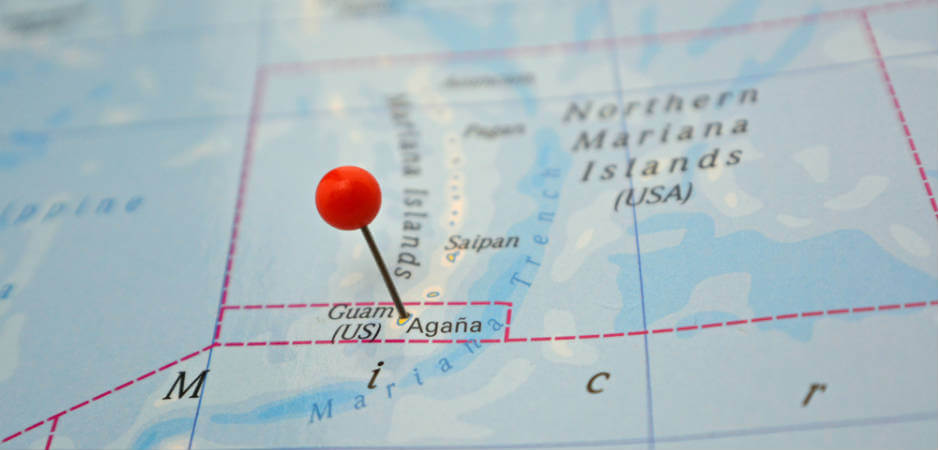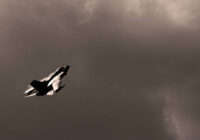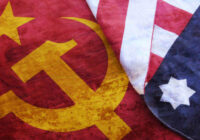US grandstanding over Guam would not be so worrying if it were not for the possible involvement of nuclear weapons.
The standoff between North Korea and the United States has been brewing since the leadership changed in both countries. Kim Jong-un has been consolidating his position and extending his family legacy since inheriting the leadership in 2011. The Obama administration dealt with that escalation with diplomatic belligerence but little saber-rattling. In contrast, President Donald Trump has been not so much rattling the saber as displaying it unsheathed, with swishes in the air.
This grandstanding would not be so worrying if it were not for the possible involvement of nuclear weapons. It is now 33 years since Ronald Reagan’s ill-judged quip: “We begin bombing in five minutes” at the height of the Cold War on August 11, 1984. Today, the leaders of both countries involved in the latest geopolitical dispute use media to set policy in an unprecedented way. Just as with the Cuban Missile Crisis of 1962, the world watches as these tensions play out.
Then and Now
The threat posed to Guam now and that faced by Cuba in 1962 have so far played out differently. The Central Intelligence Agency’s disastrous 1961 Bay of Pigs adventurism forced Fidel Castro into the willing arms of Nikita Khrushchev. The deployment of Thor missiles to Britain and Jupiters to Italy and Turkey in the late 1950s and early 1960s produced an asymmetric threat level, which Khrushchev answered with Soviet missiles and nuclear warheads in Cuba. Despite John F. Kennedy’s “missile gap” rhetoric during the 1960 presidential election, the Soviet Union only had 15 intercontinental ballistic missiles (ICBM) in the USSR at the time of the crisis, of which only four were ready for deployment. The Americans arguably overreacted to their own policy of containment being applied back to them.
Kennedy, in contrast to Trump, kept a measured media profile. JFK is portrayed as the archetypal “cold warrior,” and initially saw the Cuban missiles as leverage to get the West out of Berlin. However, secret White House tapes the Kennedy brothers kept between 1961 and 1963 show the president was the only member of his cabinet not to advocate bombing Cuba at some point. That includes his attorney general brother, Robert (the posthumously-published Thirteen Days was an attempt by Robert Kennedy to appear a dove at the height of the Vietnam War). Kennedy was cautious with his public language, for example, by using the term “quarantine” rather than “blockade” to describe American action against Soviet ships.
Under Kennedy, a candid series of public pronouncements took place within the accepted norms of the time. “Fire and fury,” “locked and loaded” and “be very, very nervous” were not part of White House language in 1962. Today’s incumbent lacks comprehension of America’s nuclear potential. Misunderstanding what the nuclear triad meant in Republican candidate discussions with the media, staffers suggesting that if you have nuclear weapons you should not be afraid to use them, and various post-election comments by then President-elect Trump about a new nuclear arms race indicate that Barack Obama’s suggestion that this was not a man you should trust with the nuclear codes might have warranted more attention.
Kennedy maintained restraint in public and in private. This was in spite of General Curtis LeMay’s repeated jibes as the head of the US Air Force that the president’s stance was akin to appeasement — a direct reference to Joe Kennedy’s role as US ambassador to the UK between 1938 and 1940. By contrast, China is now calling for reduced rhetoric from the White House.
New Imperial Standard
None of this should overshadow the belligerence of Kim Jong-un and the North Koreans. They have been hardened by years at the center of international rhetoric. George W. Bush’s decision to include North Korea in his Axis of Evil confirmed one thing above all else to Kim Jong-un’s father, Kim Jong-il: If you have nuclear weapons, the US will not ignore you, for good or otherwise. Possession of nuclear weapons became the new imperial standard in the 1950s and 1960s, with France and Britain trading colonies for H-bombs to retain their relevance in a bipolar superpower world. India, China, Pakistan and Israel arguably have done the same in a regional context. The North Koreans have simply followed that precedent.
Could such rhetoric and posturing develop into conflict? The Doomsday Clock is two minutes 30 seconds to midnight in 2017, precisely because the potential for one-off exchanges has increased. By this measure, we have not been so close to conflict since 1953 (two minutes to midnight) — the last year of the Korean War. President Harry Truman discounted the use of atomic weapons against China at that time, partly constrained by the thought of authorizing another A-bombing of an East Asian nation. The Doomsday Clock was at seven minutes to in 1960, and moved out to 12 minutes to in 1963 (as a consequence of the Cuban Missile Crisis). Calmer heads in the White House then were able to stabilize the situation.
In 2017, we know that North Korea can detonate an atomic device; and it has a long-range missile capability. What we don’t know is whether North Korea has a warhead small enough to fit on its current missiles. That is just a matter of time. A multiple-missile test to an area near the island of Guam — a US territory and military site of long standing — would be a miscalculation. In the same way, the Kennedy administration allowing a nuclear test to go ahead during the Cuban Missile Crisis sent the wrong message in 1962.
The difference now is that the North Koreans would deliberately go ahead with a test now to gain further concessions from the US in behind-the-scenes diplomatic negotiations. No one doubts that the North Koreans would use nuclear weapons when they judge the time is right. Che Guevara condemned the Soviet Union as cowardly in not pursuing a nuclear war in 1962. He saw it as a lost opportunity — socialism would win in the apocalyptic aftermath. This echoes Chairman Mao’s speech given in Moscow in 1957, advocating “nuclear mass extinction” as a way of furthering the communist cause. We can be certain that China no longer holds this position 60 years on. In Kim Jong-un’s North Korea, the sacrifice might be deemed appropriate.
The issue is how the United States would respond if Guam were targeted with nuclear weapons. Nuclear weapons are not simply large explosives, which seems to be current White House thinking. An eye for an eye would set a dangerous precedent for the future.
*[Emmett Sullivan is co-author, with Ross Mahoney, of the FutureLearn online course From World War to White Heat: The RAF in the Cold War, which runs until September 7, 2017.]
The views expressed in this article are the author’s own and do not necessarily reflect Fair Observer’s editorial policy.
Photo Credit: JoaoCachapa / Shutterstock.com
Support Fair Observer
We rely on your support for our independence, diversity and quality.
For more than 10 years, Fair Observer has been free, fair and independent. No billionaire owns us, no advertisers control us. We are a reader-supported nonprofit. Unlike many other publications, we keep our content free for readers regardless of where they live or whether they can afford to pay. We have no paywalls and no ads.
In the post-truth era of fake news, echo chambers and filter bubbles, we publish a plurality of perspectives from around the world. Anyone can publish with us, but everyone goes through a rigorous editorial process. So, you get fact-checked, well-reasoned content instead of noise.
We publish 2,500+ voices from 90+ countries. We also conduct education and training programs
on subjects ranging from digital media and journalism to writing and critical thinking. This
doesn’t come cheap. Servers, editors, trainers and web developers cost
money.
Please consider supporting us on a regular basis as a recurring donor or a
sustaining member.
Will you support FO’s journalism?
We rely on your support for our independence, diversity and quality.







